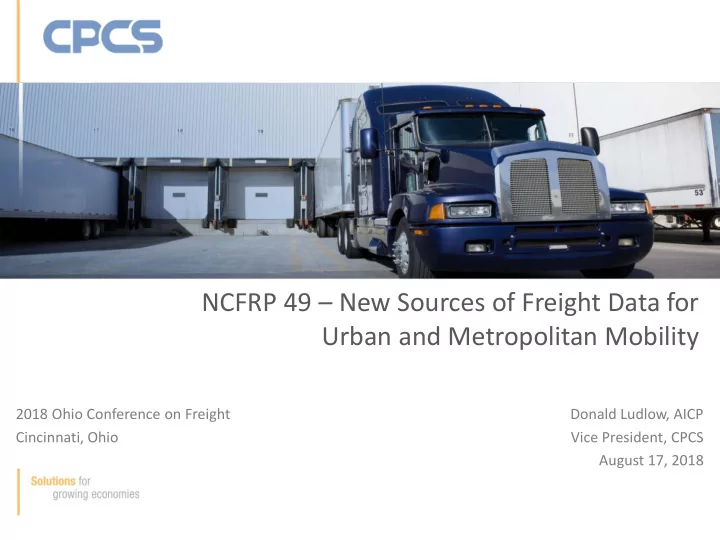

NCFRP 49 – New Sources of Freight Data for Urban and Metropolitan Mobility 2018 Ohio Conference on Freight Donald Ludlow, AICP Cincinnati, Ohio Vice President, CPCS August 17, 2018
A Fundamental Question: What Are Freight Data Data that track the movement, quantity, value, and type of goods; the conveyance, or vehicle, or the infrastructure that supports these movements. Freight data help us make decisions … 2
National Data Sets Provide Good Intercity Coverage… 3
And allow us to analyze regional freight flows… 4
But, Persistent Data Gaps Make it Difficult to Address Some Challenges in Urban Goods Movement • Focus on improving truck observability : the detailed knowledge of truck movements and factors affecting movements • Need finer-grained data to address urban and metropolitan freight mobility challenges 5
Urban Freight Challenges 6
Potential Uses of New Data to Solve Challenges 7
What are Potential Applications of [New] Data? • Truck probe data • Sensors (e.g. V2I, loop detectors, cameras) • Computer vision • Land use databases 8
Applications of GPS Data (beyond bottlenecks) • Origin-destinations, truck parking, truck touring , • Trip generation, land use, truck volume estimation, model calibration Source: ATRI 9
Urban Truck Sensing (Delivery Zones) Source: DC DOT (2016) What was the project objective? To improve urban freight sustainability through Waze- like routing for OS/OW; real-time loading zone and parking management What were the data used? Meter transactions, still and video images 10
Computer Vision • Computer Learning – Computers are Photo: Yousuf Fahimuddin pretty good at recognizing text • Latest research focused on recognizing, tagging, classifying audio and video • Computers starting to learn how to tell commercial vehicles apart
Computer Vision Example at Intersection Source: Miovision 12
Truck Speeds in Chicago from Computer Vision Truck Data in Chicago from Computer Vision • Illustrate how trucks traverse network • Can display both flows and classification data • Need appropriate data source, ex. manual vs computer vision vs GPS Source: CPCS analysis of data from Miovision, Fish Transportation Group, AES Services Inc., and Gewalt Hamilton Associates Inc. 13
Truck Speeds in Chicago from Computer Vision Source: CPCS analysis of data from Miovision, Fish Transportation Group, AES Services Inc., and Gewalt Hamilton Associates Inc. 14
Truck Speeds in Chicago from Computer Vision Source: CPCS analysis of data from Miovision, Fish Transportation Group, AES Services Inc., and Gewalt Hamilton Associates Inc. 15
Real Estate / Business Records to Visualize Freight and Land Use • Real estate / business records to assess / visualize freight clusters • Combine with other sources (e.g. truck GPS speed data, counts, volumes) Source: CPCS – MetCouncil Freight Corridors Source: CPCS – Met Council Freight Corridors
Key Themes in Applying Freight Data to Urban Freight • Data Fusion. Most “new” data sources must be “fused” with other sources— especially location- based data — to provide value. • Analytical Frameworks. The analytical procedures and business models are as important as the data sources. • Applicability of Data to Challenges . The value proposition of any new data source is tied to the applications that the data can support (e.g. how it addresses freight mobility challenges). 17
Considerations for Transportation Agencies • Which freight mobility challenges do you face that freight data may inform or resolve? • What are your data gaps and which emerging data sources may help close them? • What are examples of best practices in applying new data sources? • What are the next steps to leverage data to inform issues? • What resources are needed staff, IT, external advice or systems? 18
Questions and Discussion Donald Ludlow, MCP, AICP Vice President, United States 1000 Potomac St. NW, 5 th Floor, Washington, DC 20007 C: +1 703 216 2872 | dludlow@cpcstrans.com | www.cpcstrans.com 19
Introduction to CPCS Global management consulting firm (formerly consulting arm of Canadian Pacific Railway, est. 1969) • Strategy, economic analysis, policy, specific to transportation and energy sectors • Multimodal transportation practice (road, rail, air, marine, pipeline) • Global presence and experience • Over 1000 projects in more than 90 countries CPCS countries of work experience (shaded) and offices Recent North American project experience: • Arizona State Freight Plan • Ohio Maritime Strategy • Florida Last-Mile Freight Data Strategies • NCFRP 49 – New Freight Data Sources • American Highway Users Alliance National Bottleneck Study • Toronto Off-Peak Deliveries Pilot • Twin Cities Regional Truck Highway Corridor Study 20
Summary of Recent CPCS Experience Freight Port & Multi- Passenger Rail Terminals modal & Transit Transport 100+ Strategy 35+ Strategy 10+ Strategy projects projects projects 30+ Strategy 8 Transactions 30+ Transactions 3 transactions projects $3+ billion in deals $5+ billion in deals $3 billion in deals 21
Recommend
More recommend